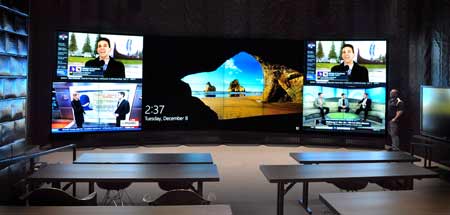Video wall displays are one of the most powerful advertising tools available to companies. Digital displays are quickly replacing other forms of message delivery, according to a survey published by Nielsen Audio (formerly Arbitron). The survey showed that 47 percent of people who had seen a video wall in the previous month recalled at least one ad they saw. Video wall displays make an impression on people, and they get people to act. That same Nielsen Audio study also found that 80 percent of consumers have entered a shop because digital signage convinced them to do so.
With this information, it’s easier to understand why so many companies, schools and other organizations are investing in video wall displays. That’s because video walls do more than enhance advertising and branding efforts; they also welcome, inform and entertain guests.
Any Organization Can Benefit from Video Wall Displays
By 2020, market forecasts have the digital signage industry growing to about $20 billion, and video walls are a large part of that. This impressive growth can be attributed to the success of digital displays, which are a noticeable improvement over static signage. Consider everything a video wall display can do that print signage cannot:- Present vivid graphics, video and animation – People are wired to detect color and motion in their environment, and video walls deliver both better than any other medium. An untouchable advantage of video wall displays is that they can be scaled up with no loss of resolution. In fact, as displays are added to the wall, total available resolution climbs, so companies, organizations and venues can get creative with the visuals they use.
- Deliver targeted, timely messaging – Video walls can be updated in real time and programmed to run certain layouts at certain times. This allows video wall owners to reserve layouts for when they would be most effective. For example, a restaurant could use their video wall to advertise drink specials as soon as happy hour kicks in. A grocery store could program their video walls to offer product suggestions for early morning commuters or people shopping for dinner. A university could program and schedule layouts for game or orientation days, welcoming visitors and helping them navigate the campus.
- Build engagement and spirit – Every organization, including businesses and schools, could benefit from a more unified workforce or student body. Video walls can reinforce organizational spirit, celebrate individual or team achievements and remind people of important events. In the morning, they can welcome people to the office or on campus, and when it’s time to go home, those same video walls can provide traffic or weather information, along with a pleasant goodbye. It’s these small touches that can make people feel like they are part of a whole.
- Synergize with social media – Branding is far more effective when it is backed by successful social media campaigns. Video walls can be linked to an organization’s social media accounts and used to broadcast posts, photos or videos. Businesses can encourage their customers to leave a positive review or message that is displayed on the video wall and through a popular social media app. Universities can accomplish something similar with their video wall, by having students leave short positive posts about the school and what it means to be a student there. These are just ideas, but they illustrate what can be done with video walls and a creative mindset.
Where can video walls make an impact?
Video walls sell themselves, but they are still tools, which means they work best when handled by an expert. Audio and video integrators are the professionals to call in this instance, and experienced integrators know where video walls should go to maximize their effect. Some common spots for video walls include:- Building lobbies and visitor information centers – Video walls are strong information delivery vehicles, so they should be used where people are likely to need direction. Video walls can provide directories or instructions, which is useful for visitors, customers and the employees tasked with helping them.
- Conference rooms – A video wall can be used to enhance presentations, bring in remote parties and establish a workspace for documents and media. When used in a conference setting, video walls improve meeting engagement and collaboration, as meeting members can use some of the video wall workspace for visual brainstorming and idea keeping.
- Training or instruction areas – Video walls also make excellent training and teaching tools, for the same reasons they make excellent collaborative tools. Interactive video walls are an especially compelling choice for communicating lessons, as the instructor can control the display without being tied to a podium.



